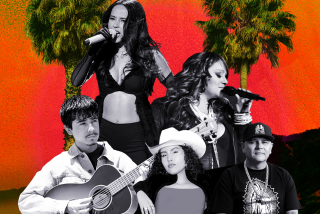ART REVIEW : THE MEXICAN REVOLUTION RECAPTURED
- Share via
If you stand in a central spot in “The World of Agustin Victor Casasola, Mexico: 1900-1938,” an exhibition of documentary photographs at UCLA’s Frederick S. Wight Gallery, you get a capsule view of the Mexican photojournalist’s expansive vision. Facing you is a photo mural of pre-revolution Mexican dignitaries, formally dressed and lined up for an official portrait. On the far left, an enlargement of a distinctly different subject pictures lowly sanitary and transportation laborers, crowded around a banner of the Mexican Regional Confederation of Workers. And to the right is a wall-size photograph of soldiers, marching off to war in enormous sombreros.
Rulers, workers, revolutionaries--these three images sum up the scope of smaller pictures in the exhibition and of Casasola’s career as a photojournalist and archivist. A pioneering press photographer, Casasola began his career as a typesetter and a reporter before taking up a camera as a better means of communicating with Mexico’s largely illiterate population. He worked for major newspapers and, in 1911, founded the country’s first Assn. of Press Photographers.
Casasola is known as the photographer of the Mexican Revolution but, as a catalogue essay notes, he was primarily an urban photographer who concentrated on life in Mexico City. Making it his business to compile a massive pictorial record of his era, he established a photo archive of his work and that of his contemporaries. Since his death, in 1938, the archive has been maintained and expanded by his family. It is housed in Pachuca under the auspices of the National Institute of Anthropology and History.
According to catalogue text prepared at the archive, there is some confusion about who actually took some of the pictures in the collection: “The photographer/archivist’s overriding concern was recording the fact rather than registering authorship.” While the preponderance of images at UCLA are probably Casasola’s own work, others (particularly those of the revolution) are thought to be the work of other photographers who tracked uprisings in the countryside while Casasola worked in the city.
The collective picture that emerges is a rich view of the strata of Mexican society during a period of turmoil, encompassing the reign of dictator Porfirio Diaz and his overthrow. Official pictures depict Diaz, his family and fellow politicians looking elegantly cultured and almost thoroughly European.
The Mexican people who bore the brunt of his oppression range from somber factory workers to child soldiers. There are families torn apart by poverty and war. We see touching pictures of orphans, men incarcerated at a correctional institute and a pile of youngsters, sleeping in the street. More sanguine images feature zany entertainers and sober portraits of leading intellectuals and artists.
The 150 photographs in the show are rarely artful, nor were they intended to be. These straightforward documents say as much or more about daily life during a revolutionary period as they do about its atrocities. Widespread unrest is generally expressed in muffled tones and its impact can only be sensed in the faces of hundreds of downtrodden people, making do or fighting however they can.
In stark contrast to the broad view of Mexican life offered at UCLA is another Casasola show that brings the horrors of the revolution into terrifying focus. “Images of the Mexican Revolution,” at Plaza de la Raza in Lincoln Park, sets forth blood-curdling realities of assassinated heroes and their killers in about 100 photos taken between 1910 and 1920.
This is a traveling exhibition from the collection of Minerva and Gilberto Martinez, a couple from Austin, Tex., who acquired the work from a grandson of Casasola. Concurrent scheduling with UCLA was a coincidence but an enriching one that fills-out knowledge of a man whose commitment to Mexico’s revolutionary period is often equated to Mathew Brady’s record of the American Civil War.
Among the pictures in the lake-side gallery, we find women accompanying their husbands to war, trudging alongside a company of soldiers and offering comfort on dusty battlefields. The men meet death individually by hanging from trees and facing firing squads, or collectively in lines of battle.
Paradoxically, these often grisly pictures look more like art than those at UCLA, probably because they are printed in sepia tones on textured beige paper. But again, the point isn’t aesthetics--it’s social content and it’s here in quantity. The history revealed in the pictures and accompanying text is authentically moving.
One after the other, men of both the cloth and the sword fall to their opponents’ force. One who survives, Francisco Madero, lives to become president but proves a weak leader and is murdered by Diaz sympathizers. Diaz himself, unfailingly handsome and proud, gets sent off to exile aboard a German ship in 1911 after 34 years of ruling Mexico.
The UCLA exhibition, funded by the Ford Motor Co., was organized by Fonda del Sol Visual Art and Media Center in Washington. In conjunction with the show, UCLA’s Grunwald Center for the Graphic Arts has staged a complementary, three-part presentation: illustrations by artist Jose Guadalupe Posada, work by members of a graphic arts collective called TGP ( El Taller de Grafica Popular) , and three astonishing woodcut murals from revolutionary Cuba. Both shows continue through Dec. 29, upstairs at the Frederick S. Wight Gallery.
Plaza de la Raza’s exhibition, sponsored by Miller Brewing Co., runs through Dec. 28.
More to Read
The biggest entertainment stories
Get our big stories about Hollywood, film, television, music, arts, culture and more right in your inbox as soon as they publish.
You may occasionally receive promotional content from the Los Angeles Times.










